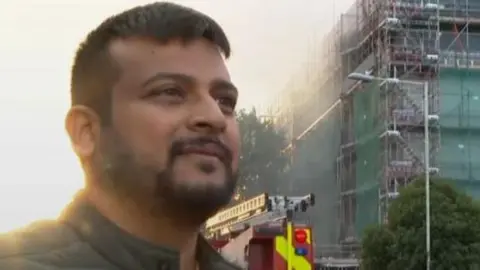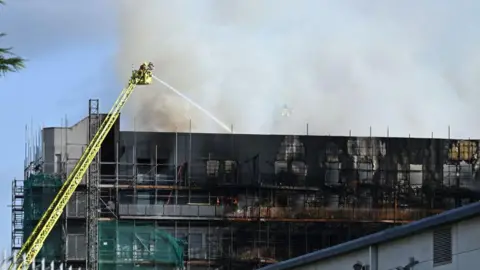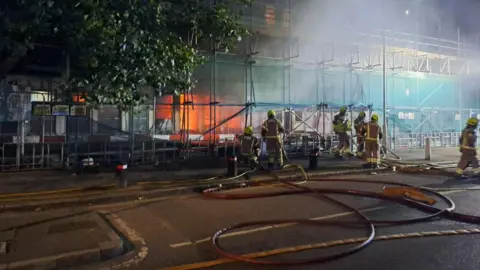Residents who fled a burning tower block in east London told the BBC they were terrified and their families had lost everything.
Tariq Ziad, 17, described smoke quickly filling the fourth floor of Dagenham as the fire engulfed the building in the early hours of Monday morning.
More than 80 people were evacuated, two were taken to hospital and all occupants of the building have been accounted for, according to the London Fire Brigade (LFB).
The fire service has said the building is “aware” of safety issues, and the role the cladding played will be part of the investigation.
About 225 firefighters were dispatched to the scene in Freshwater Road at 02:45 BST when the fire broke out in the building, including scaffolding and the roof.
A major incident was declared by the fire service. It has now been stopped but crews will remain at the scene until Tuesday, the LFB said.
Mr Ziad lived in a mixed commercial and residential building with his father, and the pair knocked on neighbours’ doors to raise the alarm before rushing downstairs to safety.
“One breath (of smoke) constricts the lungs, you can’t breathe, it attacks you,” he said.
Mr Ziad said he believed some of the fire alarms appeared to be malfunctioning, as he pressed two – next to the stairs on the fourth floor, and at the entrance – and one made a brief sound “but there was no siren”.
“It’s a bit busy, I’m still trying to sink in. We’ve lost everything but what’s at the end of the day,” he said.
Karthick Kannaiah and his wife Meghana rushed out of their flat with their friend’s six-month-old baby and six-year-old daughter after waking up to the smell of smoke.
Mr Kannaiah said he opened the window to see the flames after his wife told him the scaffolding outside was on fire.
“It was like I was watching a horror movie,” he said.
“We opened the door and saw people running to the stairs. We somehow got out of the building with our baby.”

The six-year-old girl’s father told the BBC that his friend and daughter were “calm now, but scared” at the time of the blaze.
Dinesh Raj said he got a call that the building was on fire at around 03:00 and rushed to the spot in his car.
He said the family rushed outside after smelling smoke, holding their six-month-old baby and daughter.
When they left the building, the fire had spread to the upper floor, he said.
A resident who lives on the first floor of the building told the BBC that he had been woken up on Monday morning by one of his neighbors frantically banging on the door.
Residents, who did not want to be named, said their neighbors did the same to all the flats in the corridor.
He said he saw the fire “exploding” and was relieved to get out safely.
Evacuated residents have been taken to a rest area that has been set up at a nearby recreation center.
 Getty Images
Getty ImagesAssistant London Fire Commissioner Patrick Goulbourne said: “The building has a number of fire safety issues that are known to the London Fire Brigade.”
Questions about the cladding’s role in the fire will be part of a full investigation into the incident, he said.
It is not yet known what caused the fire, however according to a Facebook post from the contractor building which “non-compliant” cladding is in the process of being removed.
A planning application document also details “remedial” work carried out to remove and replace “non-compliant cladding” on the fifth and sixth floors containing the flats.
Mr Goulbourne also urged people to avoid the area, adding that residents should keep their doors and windows closed as the fire was still producing smoke.
 London Fire Brigade
London Fire BrigadeIn 2022, the government introduced Building Safety Act – in response to the Grenfell Tower fire in 2017 – making sure that most leasehold flat owners are protected from dangerous cladding costs.
The government has also introduced a scheme that forces developers and social landlords to take measures to replace layers that are unsafe, or at risk. forbidden to build residential houses in England.
According to government figures published last week, 4,630 residential buildings 11m and taller had been identified as having unsafe coatings by the end of July this year.
Half of these buildings have started or finished work to remove the cladding. Only 29% of these buildings have completed remediation work.
A final report on the Grenfell Tower Inquiry is here due to be released next week.





